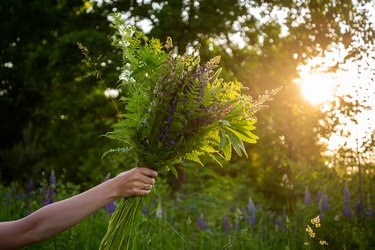
Ferns in floral arrangements can elevate a traditional arrangement to a stunning wildflower collection. Seen growing in the wild more often than not, they bring a unique, natural feel to bouquets. With a variety of types of ferns for bouquets, you can create endless numbers of beautiful flower arrangements.
The Anatomy of a Bouquet
Video of the Day
There are four floral components of a bouquet. When assembling a bouquet or flower arrangement, focal flowers, secondary flowers, textural flowers and foliage are all utilized to create a dynamic, striking work of art. Focal flowers are the central flowers featured in the arrangement and are chosen for a variety of reasons, from appearance to sentimentality. They're complemented by the secondary flowers, which create visual movement throughout the bouquet, giving the eye more to take in.
Video of the Day
Textural flowers are added to make the bouquet cohesive, tying the focal and secondary flowers together without upstaging the others. Lastly, foliage is added to tie together the whole bouquet. Also known as greenery, there is a wide variety of foliage available that has the potential to tip the bouquet toward formal or traditional. Ferns are often utilized in floral arrangements and bouquets as foliage.
Ferns in Flower Arrangements
Primarily grown in Florida, the most common fern utilized in floral arrangements is the leatherleaf fern. Florida is the national leader in domestic cut and cultivated greens. Florida's production of floral arrangement ferns began when asparagus fern growers were able to ship ferns on ice via trains to Northeast florists around the turn of the 20th century.
By the 1980s, Volusia County was the top county in foliage production in Florida, with over 3,300 acres. Over 90 percent of the acreage is dedicated to growing leatherleaf ferns, which are popular in floral arrangements.
About Leatherleaf Ferns
Leatherleaf ferns (Rumohra adiantiformis, USDA plant hardiness zones 9b to 11) are perhaps the most popular fern. They can grow between 12 and 24 inches tall and 5 to 8 inches wide. They have the characteristic fern shape with tufted, pinnate leaves. A leatherleaf fern is often used in floral arrangements. They are popular for their year-round seasonality and versatility, and they make a great base for most arrangements.
About Sword Ferns
Sword ferns (Nephrolepis exaltata, USDA plant hardiness zones 10 to 12) are only available during the spring and fall months. Able to grow to 12 to 16 inches, these ferns grow in a sword shape, which is contrary to the leatherleaf ferns, which start wide and narrow toward the top. Popular for tropical designs, sword ferns are a great way to add height to an arrangement.
About Tree Ferns
Tree ferns (Asparagus virgatus, USDA plant hardiness zones 7b to 10b) are another fern with year-round seasonal availability. Able to grow to 15 to 22 inches, tree ferns have needlelike foliage, unlike the pinnate foliage of the other ferns. Tree ferns appear almost bushy with delicate, wispy fronds. Tree ferns are versatile fillers that complement most designs. Their delicate fronds can be cut down and used in smaller arrangements, such as corsages and boutonnieres.
About Foxtail Ferns
Foxtail ferns (Asparagus densiflorus 'Myers,' USDA plant hardiness zones 9 through 11) have the tall shape of the sword fern with the needlelike foliage of the tree fern. Able to grow to 18 to 24 inches, these ferns are also available year-round. Their shape and size make foxtail ferns ideal for adding height to arrangements. Unlike the other ferns, foxtail ferns can be bent and secured into shapes. They're also sturdy enough to withstand spray paint.
- Amanda Day Rose Florals and Events: Anatomy of a Bouquet (and Why it is Important)
- Florida Department of Agriculture and Consumer Services: Ferns for Floral Arrangements
- Florida Department of Agriculture and Consumer Services: Leatherleaf Fern, Leather Fern
- Florida Department of Agriculture and Consumer Services: Sword Fern
- Florida Department of Agriculture and Consumer Services: Tree Fern, Tiki Fern
- Florida Department of Agriculture and Consumer Services: Foxtail, Myerii, Myers Fern